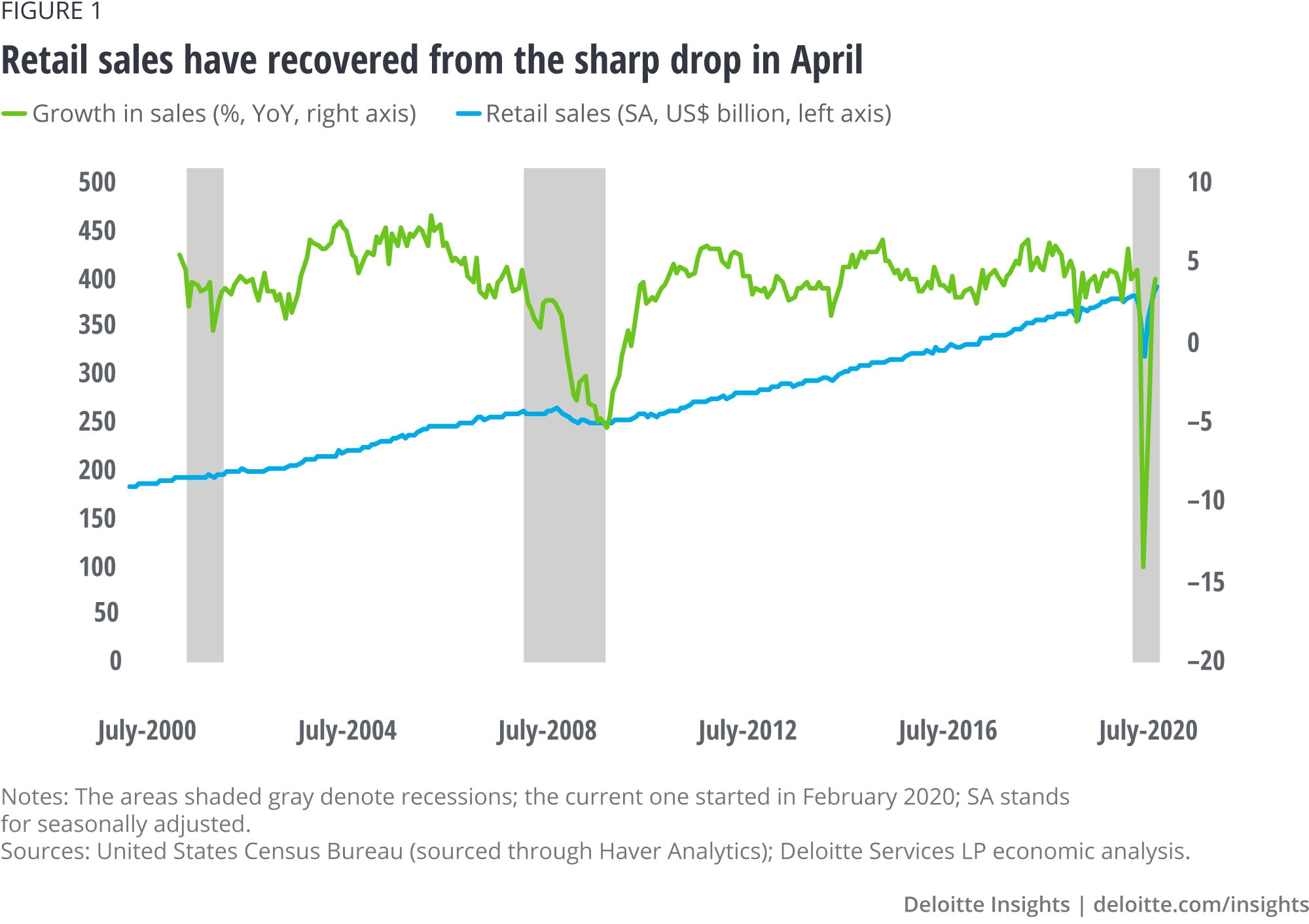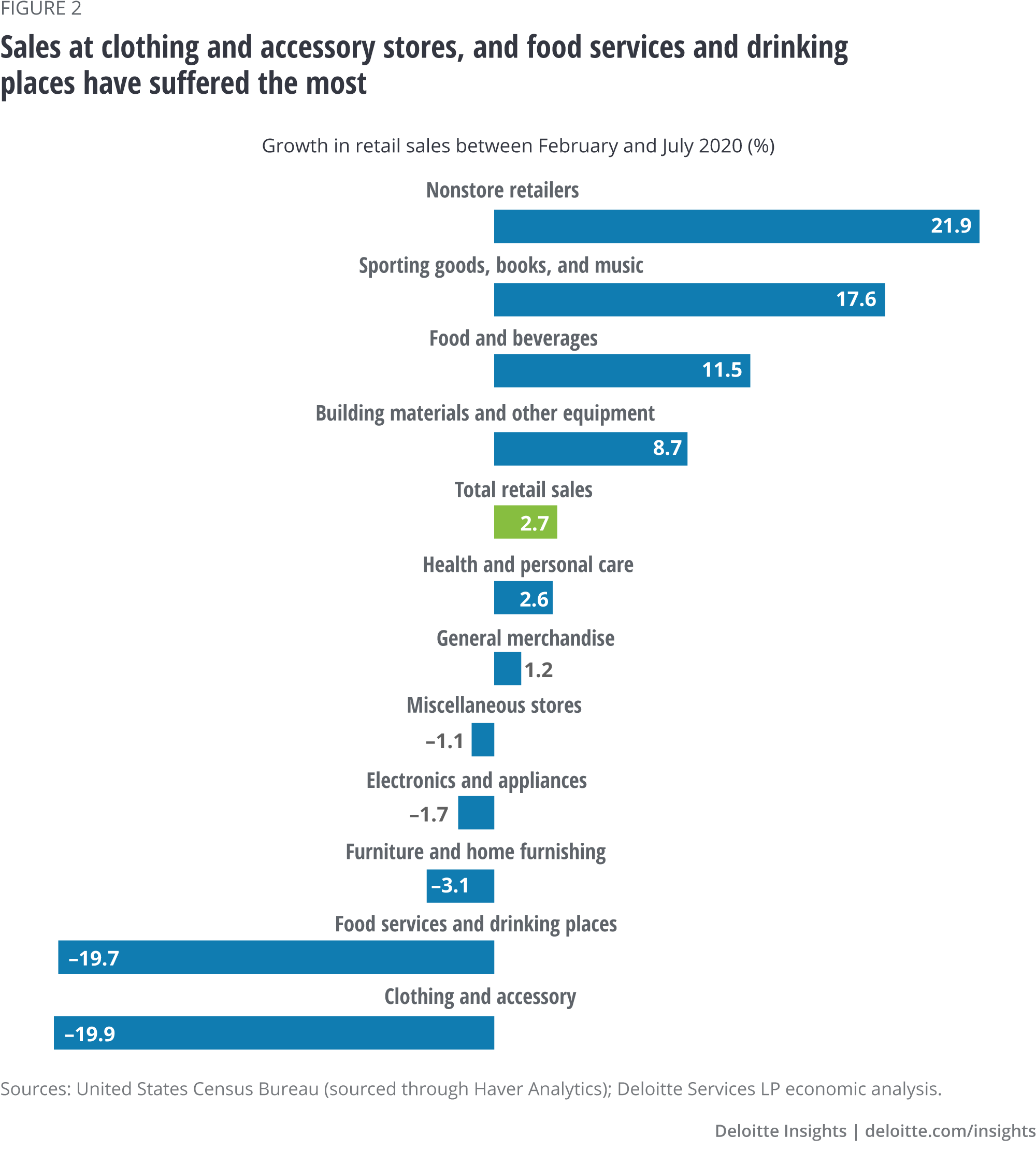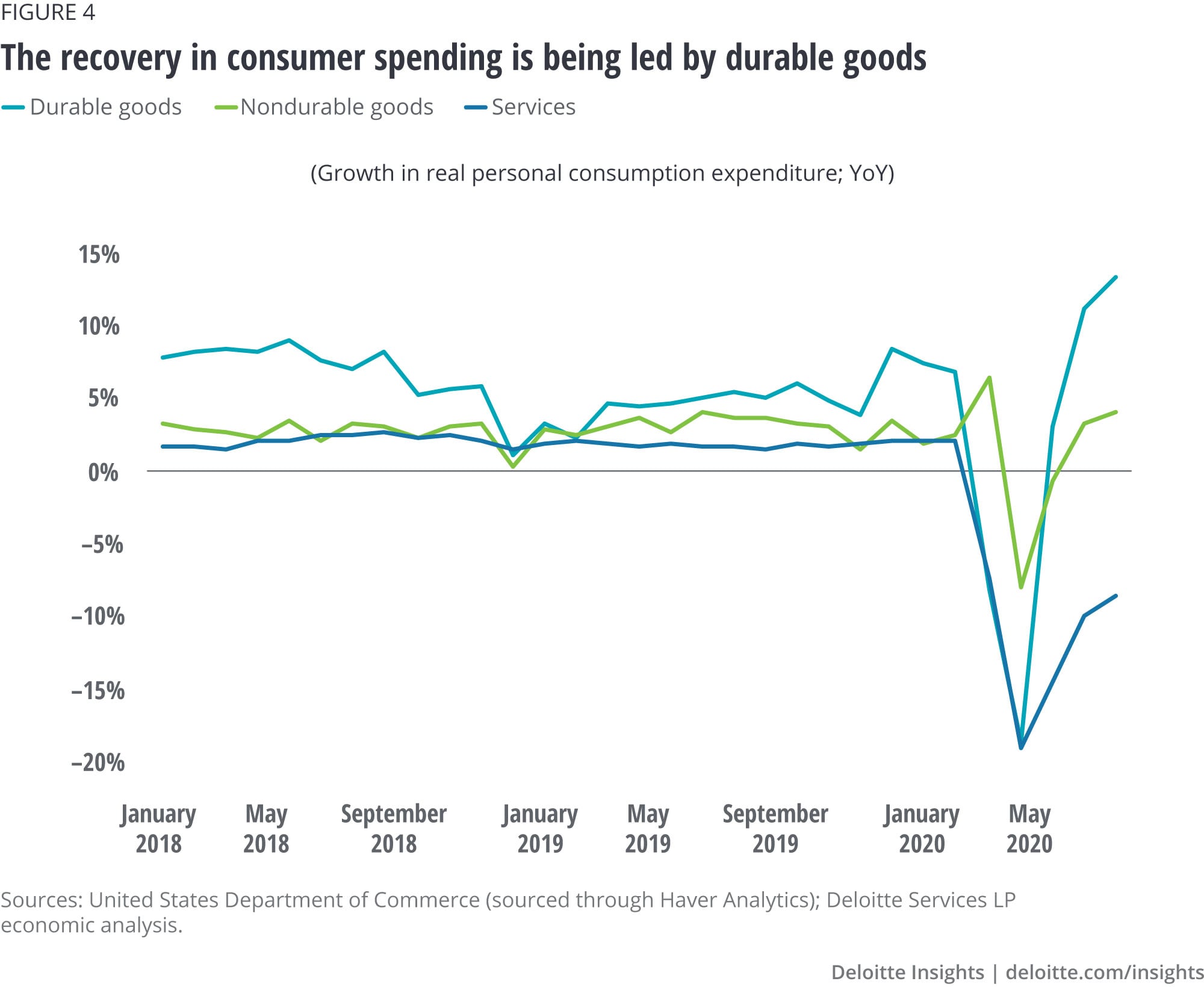
A recovery in retail sales is underway amid COVID-19, but there are challenges ahead Economics Spotlight, September 2020
7 minute read
26 September 2020
There has been a slight, albeit uneven recovery in retail sales since May as consumers shift spending to goods from services. However, fears of contracting the virus given the pandemic and concerns around jobs and personal finances are likely to weigh on retail sales.
The sharp drop in retail sales1 in the United States in April due to the spread of COVID-192 now appears to be a thing of the past with sales recovering steadily since May.3 Yet, not all retailers have fared the same. For example, sales continue to be subdued relative to prepandemic levels in food services and drinking places as people remain wary of visiting establishments where social distancing is limited. Similarly, sales at clothing and accessory stores remain weak as people cut back on spending due to more “work from home” and out of concern for their personal finances given rising risks to jobs. Health-related worries have, however, been a boon for e-commerce as consumers ramp up shopping from the safety of their homes. This boost to e-commerce is likely to continue in the near term given that any deployment of a safe and efficient vaccine for a majority of Americans may not happen before the middle of next year.4 And while the pandemic and its economic impact will continue to generate headwinds for retail sales, it does have a tailwind surprise: As people shy away from travel and recreational services due to health concerns, sales of some goods will likely benefit as consumers shift some of their spending to products from services.
Retail sales are recovering, but not evenly
Learn more
Learn how to combat COVID-19 with resilience
Explore the Economics collection
Learn about Deloitte’s services
Go straight to smart. Get the Deloitte Insights app
Retail sales have been recovering since the trough of April when sales fell 14.3% from the previous month. In June, sales crossed February’s prepandemic level, and in July, they went up by 1.2% to about US$391 billion. And despite the sharp dent to retail sales in April—a contraction far higher than in any month during the two previous recessions (figure 1)—overall, sales have fared better than in the previous recession (figure 1). In July, for example, retail sales were up 2.7% from February—the start of the current recession5—marginally lower than the 2.8% rise in sales in the recession between March 2001 and November 2001, but much better than the 3.6% contraction during the previous recession.

The recovery in retail sales, however, hasn’t been uniform, with some retailers faring better than others. Sales at clothing and accessory stores, for example, were still 19.9% lower in July than in February, while in food services and drinking places, sales were down 19.7% during this period. This contraction contrasts with strong growth in sales at food and beverage stores (11.5%) and sporting goods, hobby, book, and music stores (17.6%), as shown in figure 2. Figure 2 also reveals the stellar expansion in nonstore sales since the beginning of the pandemic. Interestingly, while sales have started recovering for all types of retailers, the recovery has been volatile for some, such as food and beverage stores, while for others such as clothing and accessory stores, the pace of recovery appears to have slowed (figure 3).


Fear of the virus, concerns about jobs, and changing behavior are impacting retail sales
The diverging fortunes of different retailers are likely due to three key reasons. First, as consumers try to protect themselves from COVID-19, they are curtailing spending at establishments where social distancing is difficult, such as food services and drinking places. For example, as COVID-19 spread in March and April, consumers’ fears about the virus and shutdown orders in multiple states meant that sales at food services and drinking places fell 30% in March and then by a further 34.3% in April. Even though sales have revived somewhat—given the increase in the use of drive-throughs, takeout, and online deliveries—high levels of new infections mean that the recovery has been relatively slow. According to Deloitte’s State of the Consumer Tracker,6 only 40.3% of respondents in the United States in the latest survey (August 287) feel safe going to restaurants. Worries about health due to the pandemic8 also explains the surge in online spending—retail e-commerce9 sales grew by 33% in Q2 from the prior quarter10—as people opted to shop more from the safety of their homes.
Second, with the labor market hit hard by the current recession, consumers are increasingly worried about their jobs and personal finances.11 Employment in July, for example, was 9.6% lower than February, while the unemployment rate has gone up to 10.2% from 3.5% during this period. Consequently, consumers appear to be cutting down on spending they deem as “nonessential.” That’s not all. With social gatherings restricted and many working from home, consumers are not spending as much as they used to on services such as transportation and goods such as clothes (see sidebar, “Recovery in consumer spending is being led by services”)—this likely explains the sharp drop in sales at clothing and accessory stores. In contrast, sales at food and beverage stores have gained—sales rose sharply in March (26.9%) due to some panic buying—as people not only stocked up on groceries but also substituted eating at restaurants with more meals cooked at home.
Finally, it is likely that consumers are increasingly substituting purchases of goods for purchases of services (see sidebar, “Recovery in consumer spending is being led by services”). So, even as vacations, restaurant meals, sporting events, and gyms take a backseat, consumers who are spending more time at home are focusing more on dishing out home-cooked meals and spending more on recreation and fitness-related equipment. This likely explains the sharp surge in sales in May and June at sporting goods, hobby, book, and music stores.
Recovery in consumer spending is being led by durable goods
Real personal consumer expenditure (PCE) has been going up after contracting sharply in March (–6.5%) and April (–12.4%). This recovery is mostly being led by a surge in spending on goods, especially durable goods (figure 4). Spending on durable goods was up 11.8% in July compared to February while PCE on nondurables was 4.2% higher; in contrast, spending on services has been subdued, down 9.7% in this period. Analysis of more granular PCE data (available quarterly) reveals that the disproportionate impact on services spending is likely due to consumers cutting back on purchases deemed nonessential, or because such purchases involve going to a venue where the risk of contracting COVID-19 is relatively high.12 For example, PCE on recreational services fell by 49.5% and food services and accommodation spending by 34.2% in Q2 as consumers shied away from theaters, theme parks, restaurants, and bars. Similarly, spending on transportation services also suffered in Q2 as many people shifted to remote work and shunned shared forms of communal travel.13 With key spending avenues out of reach due to health concerns, consumers have instead increased spending on goods—PCE on recreational goods and vehicles expanded 8.9% in Q2 while spending on motor vehicles and parts grew 1.4% in this period.

The pandemic’s trajectory and the nature of fiscal response will impact retail sales in the near term
The spread of COVID-19 is likely to continue given that a vaccine and/or a treatment14 is not expected to be available before the end of 2020 or early 2021. A vaccine, even if it is found to be safe and effective, will take time to be deployed for use by a major share of the population. Consequently, the virus is expected to continue weighing on consumer spending and retail sales in the near term. The timeline involved in vaccine deployment also means that normal economic activity is unlikely to begin to resume before mid-2021, thereby weighing on labor market prospects. The elimination of the US$600 supplement for Unemployment Insurance (UI) will, however, hit those who have been laid off. And in the absence of a relief act to replace the UI supplement, income growth amid subdued economic activity will remain weak.
Most at risk from the elimination of the UI supplement are low-wage earners given that the recession has hit low-wage occupations more than others (and as compared to previous recessions).15 Between February and July, employment in low-wage occupations fell by 13.5%, far higher than corresponding declines for medium-wage occupations (–8.4%) and high-wage ones (–2.7%). This has likely created a unique situation where high-wage earners may not be willing to raise spending due to virus-related constraints—thereby limiting discretionary activities such as travel, sporting events, and theater—while low-wage earners are unable to spend more due to fears about their jobs and a lack of adequate unemployment support.
State and local governments are also facing large budget shortfalls as their tax revenues have fallen due to declining economic activity, and expenses have shot up due to higher spending on public health. Spending by state and local governments fell 5.6% (seasonally adjusted annual rate) and will likely fall more substantially (including significant layoffs) in the near term without bridge funding from the federal government given the absence of a relief act.16
All these will likely weigh on the pace of recovery in retail sales in the near term, including the holiday season. Deloitte economists expect retail sales to increase by just 1–1.5% year over year between November 2020 and January 2021, down from the 4.1% rise in the previous holiday season.17 Retail e-commerce is likely to fare much better—in line with current trends—with sales expected to rise 25–35% in the upcoming holiday season.18 While any delay in vaccine development may add to headwinds on holiday sales, continued shift in consumer spending to products from services will likely be a timely tailwind.
© 2021. See Terms of Use for more information.
More from the Economics collection
-
Asia’s economic recovery Article4 years ago
-
Japan economic outlook, February 2025 Article1 month ago
-
India economic outlook, January 2025 Article2 months ago
-
A view from London Article3 days ago













